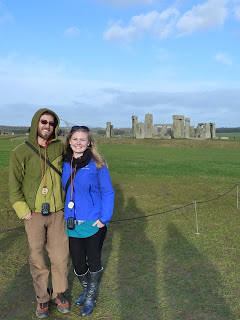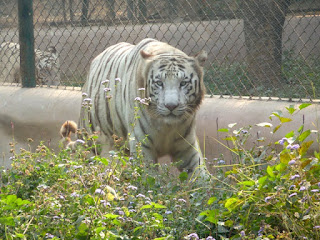 Our time in the U.K. was short, but wonderful and much needed. Bit of a culture shock at first with all the clean streets, orderly traffic, and helpful locals, but it was a welcome change. Spending our last 10 days in the U.K. was the perfect way to wrap up our trip and get us back to a state of mental sanity once more. I think we all needed the decompression time after the craziness of India. We rented a car for our first 8 days in the U.K. so that we could see as much as possible, and no longer have to rely on public transportation.
Our time in the U.K. was short, but wonderful and much needed. Bit of a culture shock at first with all the clean streets, orderly traffic, and helpful locals, but it was a welcome change. Spending our last 10 days in the U.K. was the perfect way to wrap up our trip and get us back to a state of mental sanity once more. I think we all needed the decompression time after the craziness of India. We rented a car for our first 8 days in the U.K. so that we could see as much as possible, and no longer have to rely on public transportation.
Our first few days were spent in Oxford with Erinch (a good friend of Eric's) and his three roomates, who were kind enough to let us crash in their spare bedroom, take REAL warm showers, and show us around the beautiful town of Oxford. Our time was short, but we were able to see quite a lot and it felt great to be among friends. We saw Christchurch Cathedral and the great hall where Harry Potter was filmed, walked along the banks of the river Thames, and Got a burger and beer in the famous Turf Tavern (the tavern where Bill Clinton "did not inhale"). Also while in Oxford went to Primark (clothes store) to complete my European integration outfit which consisted of boots, scarves, jeans, and a peacoat. Yes! I finally felt clean and like myself again!


Then Eric and I took to the open road and made our way to Stonehenge. From what I had heard you weren't allowed to go up to the stones, but I was pleasantly surprised to find a footpath which led us all the way around the monument, affording great views, and bringing us within 20 feet of the stones. It was impressive. The stones were HUGE and the place just had a feeling of antiquity and mystery about it. We listened to an audio tour to learn what's actually known about the stones and the people who built the structures. Stonehenge was always on my list of things to see in my lifetime, and it didn't disappoint!
 Stopped in Bath for dinner, then crossed the bridge and border into Wales to stay in the capitol of Wales and seaside town of Cardiff. Upon crossing the border we immediately noticed the street signs made a switch over from English to Welsh and we amused ourselves for a good while trying to pronounce the amazingly long words chalk-full of consonants. It was fun to hear the Welsh language spoken as well. The next day we went out to the Gower penninsula and took a hike out to the Worms head which was full of beautiful rock formations and tide pools. Pembrokshire coast national park was another beautiful coastline we visited along with St. David's Cathedral, over 1500 years old and apparently the next best thing to visiting Rome on the holiness scale. The lonely planet informed us that two visits to St. Davids is the equivalent of one to the Vatican, and three visits equals a pilgrimage to Jerusalem. Beautiful cathedral full of ornate woodwork and detailed stained glass.
Stopped in Bath for dinner, then crossed the bridge and border into Wales to stay in the capitol of Wales and seaside town of Cardiff. Upon crossing the border we immediately noticed the street signs made a switch over from English to Welsh and we amused ourselves for a good while trying to pronounce the amazingly long words chalk-full of consonants. It was fun to hear the Welsh language spoken as well. The next day we went out to the Gower penninsula and took a hike out to the Worms head which was full of beautiful rock formations and tide pools. Pembrokshire coast national park was another beautiful coastline we visited along with St. David's Cathedral, over 1500 years old and apparently the next best thing to visiting Rome on the holiness scale. The lonely planet informed us that two visits to St. Davids is the equivalent of one to the Vatican, and three visits equals a pilgrimage to Jerusalem. Beautiful cathedral full of ornate woodwork and detailed stained glass. Took a hike up to Dolgoch Falls and Eric and I went into picture taking frenzy with all the beautiful trees, moss, ferns, waterfalls, and caves. I think we might have been a bit nature deprived. The hike was short, but led us up to a pretty viewpoint of the valley below. A few days later up in Northwest Wales near Caernarfon we took another hike up the the summit of Mt. Snowdon in Snowdonia National Park. Mt. Snowdon is the highest peak in Wales or England standing at 3560 feet. The climb took us about 2 1/2 hours, and the closer we got the the summit the colder, icier, and windier it got. Even though it was a short mountain in comparison to others we've climbed, it actually felt like a summit with the biting cold and about 3 inches of fresh snow on the ground. The gusts of winds were strong enough to blow us over, but we made it, took a few quick pictures, and headed back downhill to warmer grounds. Snowdonia National Park is absolutely gorgeous. The landscape is dominated with grass shrubs, and very few trees. Lakes lined the valleys and there were beautiful boulder fields, bubbling brooks, and castle ruins strewn along our 8 mile hike.
Took a hike up to Dolgoch Falls and Eric and I went into picture taking frenzy with all the beautiful trees, moss, ferns, waterfalls, and caves. I think we might have been a bit nature deprived. The hike was short, but led us up to a pretty viewpoint of the valley below. A few days later up in Northwest Wales near Caernarfon we took another hike up the the summit of Mt. Snowdon in Snowdonia National Park. Mt. Snowdon is the highest peak in Wales or England standing at 3560 feet. The climb took us about 2 1/2 hours, and the closer we got the the summit the colder, icier, and windier it got. Even though it was a short mountain in comparison to others we've climbed, it actually felt like a summit with the biting cold and about 3 inches of fresh snow on the ground. The gusts of winds were strong enough to blow us over, but we made it, took a few quick pictures, and headed back downhill to warmer grounds. Snowdonia National Park is absolutely gorgeous. The landscape is dominated with grass shrubs, and very few trees. Lakes lined the valleys and there were beautiful boulder fields, bubbling brooks, and castle ruins strewn along our 8 mile hike. Both Eric and I were very impressed with Wales, its beautiful coastlines, National Parks, and welcoming people. It has a relaxed, slow-paced feel, and has far fewer tourists than its next-door neighbor England, but has so much to explore! Back in England, we drove into the Peaks District where we explored some awesome limestone caves affectionately named the "Devil's Arse" near the cute village of Castleton. Castleton is home to numerous cave systems, many of which are still being explored, and is also where a famous mineral called Blue John was mined back in the day. Our tour guide was a very animated and awesome lady who told us all about the history of the caves, the rope-makers who used to call it home, and the handful of movies that were filmed there including the Chronicles of Narnia (BBC version).
Both Eric and I were very impressed with Wales, its beautiful coastlines, National Parks, and welcoming people. It has a relaxed, slow-paced feel, and has far fewer tourists than its next-door neighbor England, but has so much to explore! Back in England, we drove into the Peaks District where we explored some awesome limestone caves affectionately named the "Devil's Arse" near the cute village of Castleton. Castleton is home to numerous cave systems, many of which are still being explored, and is also where a famous mineral called Blue John was mined back in the day. Our tour guide was a very animated and awesome lady who told us all about the history of the caves, the rope-makers who used to call it home, and the handful of movies that were filmed there including the Chronicles of Narnia (BBC version). Our last three days were spent in London where we were reunited with Ian and got the chance to exchange stories from our last few weeks in India. It was great to all be together again for the end of our 3 month adventure. We stayed with our friend Doris who was awesome and showed us all over London! We got around the city using a combination of buses, trains, and the underground. We saw Big Ben, Parliament, the London Eye, Buckingham Palace, Trafalgar Square, the Princess Diana memorial walkway, and Westminster Abbey. We also had time to go to the Natural History Museum and the British Museum which were both amazing and you could easily spend weeks exploring the various exhibits. It was a short period of time to explore such a vibrant, history-packed city, but we had a great time and got a good taste of London!
Our last three days were spent in London where we were reunited with Ian and got the chance to exchange stories from our last few weeks in India. It was great to all be together again for the end of our 3 month adventure. We stayed with our friend Doris who was awesome and showed us all over London! We got around the city using a combination of buses, trains, and the underground. We saw Big Ben, Parliament, the London Eye, Buckingham Palace, Trafalgar Square, the Princess Diana memorial walkway, and Westminster Abbey. We also had time to go to the Natural History Museum and the British Museum which were both amazing and you could easily spend weeks exploring the various exhibits. It was a short period of time to explore such a vibrant, history-packed city, but we had a great time and got a good taste of London! 















































